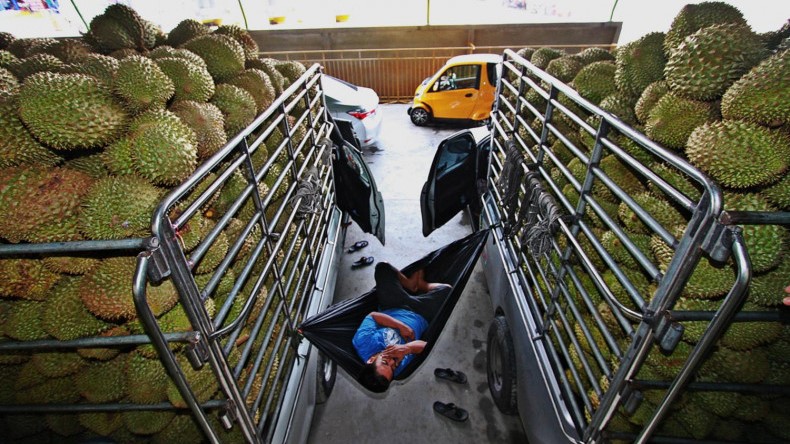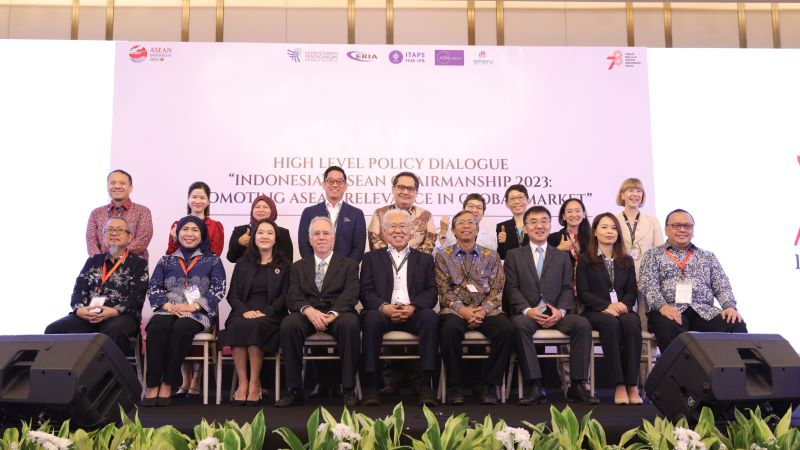Durian Powers Sino-Thai Friendship
Date:
4 July 2023Category:
OpinionsTopics:
-Share Article:
Print Article:
By Mr Kavi Chongkittavorn, Senior Communications Advisor: When it comes to the evolution of Sino-Thai relations, one must put aside all the geopolitical determinants and even such subjects as the current Russia-Ukraine war, the ramifications of the US-China standoff and tourism. The topic is durian, which serves as the weathervane of their long-standing bilateral ties. The durian, known worldwide as the "King of Fruits", is more than just a sticky, thorny and, yes, smelly fruit; they also define the nature of the five-decade-old Sino-Thai relations.
Yu Haiqiu of the Yunnan Academy of Social Science says that Thai durians were introduced to the Chinese palate a little more than two decades ago through border trade along China's southern provinces of Yunnan and Guangxi, adjacent to Vietnam and Laos. Since as early as 1958, China has tried to cultivate durians in those southern provinces but to no avail. Only in the past 20 years has the island of Hainan been able to grow durians for local consumption.
Prof Yu, an expert on Thai durians, explained why Chinese people prefer Thai durians, mainly Monthong, over other varieties. She told a Thai-China Forum last week that Chinese consumers love the yellowish colour of the Monthong and its soft creamy texture. "But they do not like the crunchy ones favoured by the Thais," she said, adding that eating Monthong was "like eating warm ice cream". In addition, they make good gifts for friends or offerings on special occasions.
And so it is that over the past two decades, the Monthong has come to dominate the durian market in China. Indeed, the King of Fruits has become the singular most important agricultural commodity being traded bilaterally. Almost all Thai durians, apart from those consumed by locals, are destined for China, amounting to 91% of the annual output. The rest goes to the US, Europe and other countries. During the first six months of this year, 94% of Thai durians were destined for China, according to the Ministry of Agriculture.
Why are durians so important in the evolution of Sino-Thai relations? First of all, Thailand was the first country allowed by China to export fresh durians for consumption. At the time, it was like a great gift bestowed upon a good friend. Other countries in Southeast Asia, which also grew durians, wanted the same privilege. None got it. Therefore, Chinese consumers are more familiar with Monthong than other types of durians.
Only recently was Vietnam allowed to send fresh durians across the Chinese border. Vietnamese durians are becoming popular because of proximity and price. The Philippines was the third country to gain permission and was added to the list in January. Other countries such as Malaysia, Indonesia, Cambodia and Australia export only frozen durians to China. Notably, the Malaysian durian, known as the Busan King, is considered premium and commands a higher price. Yet, the Busan King serves a small niche market.
Last year, China imported a total of 825,000 tonnes of durians, of which 780,000 were from Thailand and accounted for 94.5% of all China's durian imports. China spent US$4 billion (140 billion baht) out of the $14.6 billion foreign fruit budget on this creamy fruit from Thailand, which ranks No.1 among its imported fruits. Last year, Thailand exported 1.2 million tonnes of durians to China.
Huge concerns were expressed during the seminar, which was organised by the National Research Council of Thailand, over the negative impacts of being totally dependent on the Chinese market and consumers.
Several participants feared that the incoming Thai government would pursue a different foreign policy, which could cause some ruptures in current Sino-Thai relations. If any restrictive measures were imposed on Thai fruits, they would have catastrophic effects on the Thai agricultural sector. Participants cited Australia-China relations, which have impacted their economic relations trade volume, as a case study.
The high demand for Monthong in China has prompted Thai orchards to explore new land to grow durians instead of other cash crops, such as rice or maize. At this moment, every Thai province grows durians. Previously, it was concentrated in the eastern provinces of Chanthaburi, Trat and Rayong. The Thai agricultural sector is confident that in the years to come, durian exports to China will increase greatly, rising to 8 million from the current 3 million. For them, dependency is not an issue. Several participants urged the Thai durian exporters to diversify their markets to Europe, the Middle East and Latin America. The challenge is to convince new palates beyond Asia of the golden flavour that lies beyond the unpleasant smell.
But to achieve this target, there are still many issues to which the Thai government and the agricultural sector must pay attention, among them quality, branding, packaging, logistics, and even harvesting, all of which are in favour of the export of Thai fruits. According to the experts and the exporters, one of the biggest problems is the propensity to export young durians, which has greatly damaged overall durian exports to China. Normally, it takes about five to seven days by land transport to move the fruit from the two distributing hubs in Chanthaburi and Chumphon to the direct sale centres in China. By the time they arrive, the fruits would be ripe and ready to consume. Earlier harvesting, say more than a week ahead of transportation, means that the fruit would not be ripe when it reached its destination.
Both Thai and Chinese experts warned that Thai durians also need branding because, presently, there are fake Thai durians on sale in the Chinese market.
In the near term, Thai durians are having new competitors from the Vietnamese and Philippine varieties to satisfy the appetite of the Chinese market. It is, therefore, surely time for Thailand to set up direct sale centres in major cities in China. Obviously, there are still many challenges awaited due to numerous local centres. Nonetheless, with such centres in place, Thailand can export more durians that can reach consumers faster and with better quality control.
This opinion piece was written by ERIA's Senior Communications Advisor, Mr Kavi Chongkittavorn, and has been published in Bangkok Post. Click here to subscribe to the monthly newsletter.
Disclaimer: The views expressed are purely those of the authors and may not in any circumstances be regarded as stating an official position of the Economic Research Institute for ASEAN and East Asia.
(Photo credit: Pongpat Wongyala)







